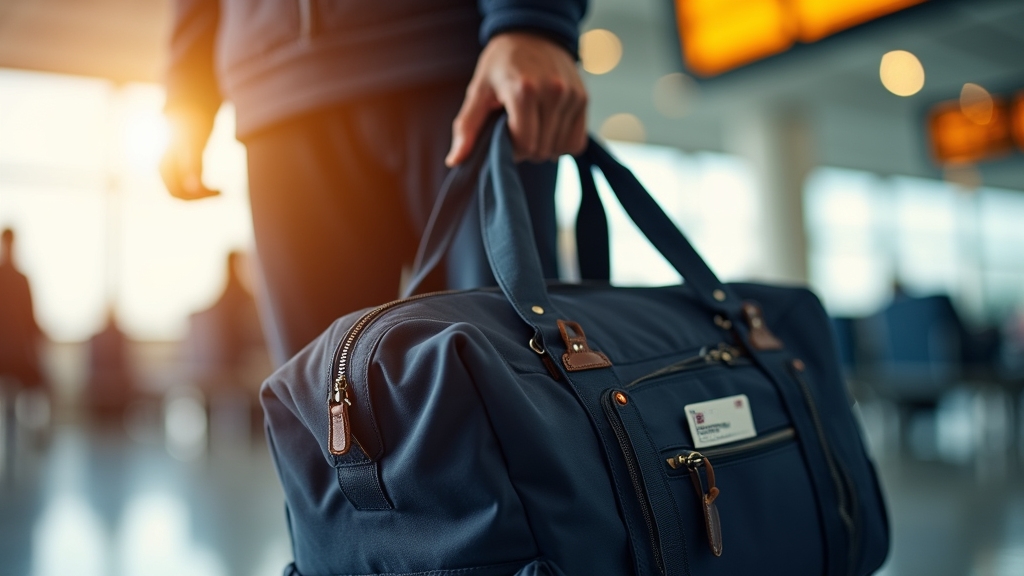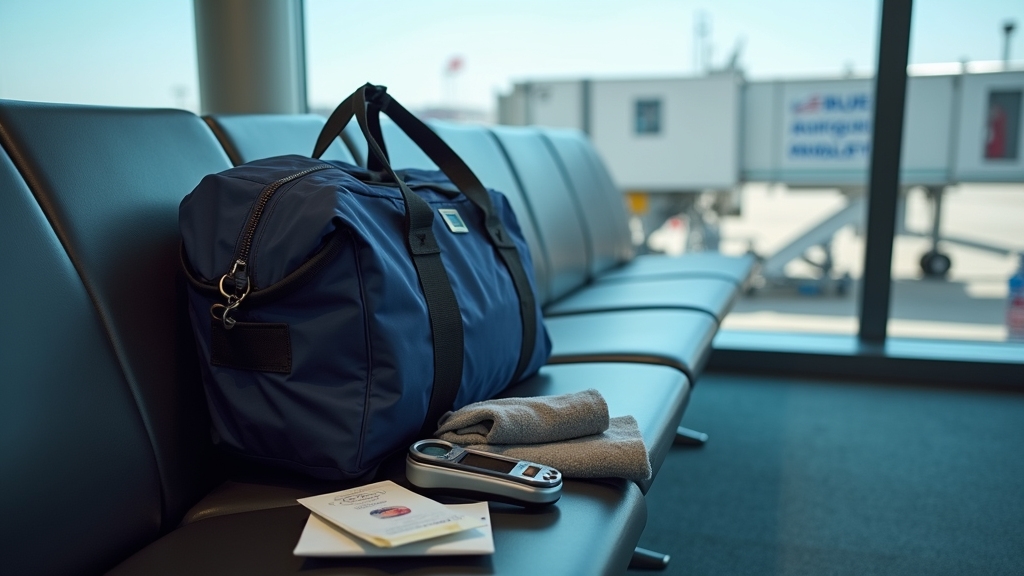
You can bring a duffel bag as a carry-on as long as it fits your airline’s size and weight limits, including handles and wheels. Duffels are lightweight, flexible, and easy to squeeze into overhead bins, making them a practical choice.
Just measure your bag carefully and use packing strategies to maximize space. Keep in mind they lack structure and may be less secure than suitcases. Want to know how to pack and choose the right duffel for hassle-free travel?
Key Takeaways
- Duffel bags are generally allowed as carry-on luggage if they meet airline size limits, typically around 22 x 14 x 9 inches including handles and wheels.
- Measure all dimensions of your duffel bag including straps and wheels to ensure it fits within the airline’s carry-on size restrictions.
- Soft-sided duffel bags offer flexible packing and can be squeezed into overhead bins or under seats, making them ideal carry-on options.
- Airlines enforce size limits strictly, so test your duffel bag in sizer boxes at the airport to avoid check-in issues.
- Choose lightweight, durable duffel bags with multiple carrying options to comply with weight limits and ease transport through airports.
Understanding Airline Size Restrictions for Duffel Bags

When you’re choosing a duffel bag as your carry-on, understanding airline size restrictions is vital to avoid surprises at the gate. Most major airlines set the maximum size around 22 x 14 x 9 inches, including handles and wheels, even for soft-sided bags. Measure your bag with all protruding parts because wheels add to overall size and can affect compliance.
Airlines typically limit carry-on size to about 22 x 14 x 9 inches, handles included. Budget carriers might have slightly different rules, so always check before you fly. Keep in mind, airlines often require your bag to fit in a sizer box, and they enforce these rules strictly.
Duffel bags with capacities around 40-45 liters usually meet these limits thanks to their flexible shape. Many airlines also consider weight limits alongside size, so weighing your bag beforehand is a good practice to ensure compliance.
Advantages of Using a Duffel Bag as a Carry-On
When you decide to go with a duffel bag as your carry-on, you’re really tapping into some great packing flexibility. I mean, just think about it—thanks to its spacious, soft-sided design, you can fit in all sorts of items without feeling restricted.
Plus, the lightweight yet durable construction means you won’t struggle to carry it around, and it’s tough enough to handle all your travel adventures. And let’s not forget about the convenience factor.
With those multiple carrying options, like shoulder straps and handles, navigating through busy airports becomes a breeze. You can easily switch up how you carry it based on what feels comfortable at the moment.
Just be sure to check your airline’s specific size and weight restrictions to ensure your duffel bag qualifies as a carry-on. Additionally, regularly caring for your luggage, such as cleaning wheels, can help maintain smooth mobility during your travels.
Packing Flexibility Benefits
Although traditional suitcases offer structure, duffel bags provide unmatched packing flexibility that adapts to your travel needs. Their soft-sided design lets you compress and fit them into tight overhead bins or under seats, making them ideal for busy terminals. This flexibility also allows travelers to use TSA-approved locks for added security without compromising accessibility.
You can pack bulky or oddly shaped items without worrying about rigid compartments and access your belongings quickly thanks to wide openings and multiple pockets. Additionally, duffel bags are constructed with durable materials that ensure they withstand the rigors of frequent travel, providing long-lasting reliability.
| Feature | Benefit | Travel Scenario |
|---|---|---|
| Flexible shape | Fits odd spaces & compresses | Crowded overhead bins |
| Large main compartment | Quick packing/unpacking | Last-minute additions |
| Multiple carrying options | Easy to carry through airports | Urban and outdoor travel |
| Expandable sides | Maximizes carry-on allowance | Weekend getaways |
| Exterior pockets | Fast access to essentials | Security checkpoints |
Lightweight and Durable Design
Because duffel bags are built with lightweight materials like ballistic nylon and canvas, they give you a durable yet easy-to-carry option for your travels. These materials resist wear and tear while keeping the bag light, so you can pack more without exceeding airline weight limits.
Reinforced stitching and heavy-duty zippers enhance durability, and water-resistant coatings protect your belongings from unexpected spills or rain. It is important to consider security measures such as using combination locks or smart locks to protect your belongings.
Unlike rigid suitcases, the flexible design absorbs bumps and jostling, reducing damage risk. Though they lack hard shells, duffel bags handle rough transit environments well, from crowded airports to outdoor adventures.
This combination of lightweight construction and toughness ensures your bag stays reliable, making it a smart choice for hassle-free, durable carry-on luggage. Additionally, duffel bags provide flexible packing options with multiple compartments, allowing travelers to organize their items according to their preferences.
Multiple Carrying Options
If you need flexibility during your travels, a duffel bag offers multiple carrying options that make moving through airports and crowded spaces much easier. You can switch between over-the-shoulder straps, top handles, and backpack straps, choosing the most ergonomic way to carry your bag depending on the situation.
This versatility helps reduce strain when maneuvering stairs, uneven terrain, or tight boarding areas. Many duffel bags are designed to complement luggage wheel types like spinner or inline wheels, enhancing overall travel convenience.
Many duffel bags also include stacking straps to attach securely on roller luggage, simplifying multi-bag travel. Plus, their soft, flexible design lets you quickly grab, lift, or adjust the bag, unlike rigid suitcases.
Whether you’re rushing through security or hopping onto crowded transport, these multiple carrying options keep you agile and comfortable throughout your journey. Additionally, duffel bags are often made from durable materials like canvas or ballistic nylon, enhancing their longevity and reliability during travel.
Potential Drawbacks of Carrying Duffel Bags on Flights
When you choose a duffel bag as your carry-on, you might face several challenges related to size, weight, security, and durability. Duffels can easily exceed airline size limits or bulge when overpacked, risking gate-checking or blocking aisles.
They often lack wheels, so carrying heavy bags strains your shoulders and back. It is important to adhere to the size restrictions set by airlines, typically around 22 x 14 x 9 inches, including all handles and protrusions, to avoid complications.
Unlike satchels, duffel bags generally do not offer ergonomic strap adjustments that help distribute weight evenly for comfort. Duffel bags often exceed size limits and lack wheels, causing strain and potential gate-check hassles.
Security screening can slow down with disorganized contents, especially since duffels usually have fewer compartments, making liquid and electronics checks trickier. Durability is another concern; soft materials and weak zippers offer little protection for fragile items and can fail under stress.
Without sturdy locks, your belongings may be vulnerable to theft or tampering. In contrast, satchels often include multiple compartments and can be paired with coordinated accessories to enhance both security and style.
How to Pack Duffel Bags Efficiently for Air Travel?
Although duffel bags offer flexibility, packing them efficiently requires smart strategies to maximize space and stay organized. Start by laying out your items and using packing cubes to keep clothes neat and visible.
Roll your clothes to save space and reduce wrinkles, placing heavier items like shoes and toiletries at the bottom for stability. Filling gaps with smaller items such as socks helps avoid wasted space and makes the best use of underseat luggage dimensions.
Use outer pockets for essentials you need quick access to, and keep electronics and toiletries handy for security checks. Avoid overpacking bulky items and monitor your bag’s size to meet airline limits, as most airlines permit carry-on luggage within 45 linear inches.
Comparing Duffel Bags With Other Carry-On Options
Packing your duffel bag efficiently sets a strong foundation. Choosing the right carry-on style can make a big difference in your travel experience. Many travelers also consider TSA locks on their luggage for added security when flying.
Compared to suitcases, duffel bags offer flexible interiors that mold to available space and accommodate oddly shaped items. Suitcases provide structured compartments for better organization and wrinkle reduction. Duffel bags flexibly adapt to space and items, while suitcases organize and protect clothes from wrinkles.
If you prioritize easy rolling on smooth surfaces, a wheeled suitcase might suit you better. However, duffel bags shine in portability—they’re lighter, easier to carry in tight spaces, and often include external pockets for quick access. Additionally, duffel bags tend to have better repairability, making them easier to fix and extend their lifespan.
Keep in mind, suitcases protect contents more securely with hard shells and integrated locks. Duffels need extra care for security. Ultimately, your choice depends on your packing style, trip length, and how you balance convenience with protection.
Tips for Ensuring Your Duffel Bag Meets Airline Policies
To guarantee your duffel bag meets airline policies, start by carefully measuring its dimensions, including any straps or pockets, to confirm it fits within the standard carry-on size limits of 22 x 14 x 9 inches. Next, check your airline’s specific size and weight restrictions, as these can vary. Weigh your packed bag with a luggage scale to avoid surprises at the gate.
Choose a flexible, lightweight duffel to maximize space without exceeding limits. Remember to bring only one carry-on plus a personal item and be aware that some airlines or fare classes may restrict carry-on allowances.
Finally, use airport sizing bins to verify compliance before boarding and prepare a backup plan in case your bag needs to be checked unexpectedly. Additionally, taking preventive measures such as using protective accessories can help preserve your duffel bag’s durability and avoid damage during travel.
Frequently Asked Questions
Can a Duffel Bag Fit Under the Airplane Seat?
Yes, a duffel bag can fit under the airplane seat if it’s small enough and packed efficiently. You’ll want to check your airline’s specific size limits for personal items, usually around 9 x 10 x 17 inches.
Soft-sided duffels are great because they can compress to fit tight spaces. Just avoid overpacking, and you’ll have no problem sliding your duffel under the seat in front of you.
Are Duffel Bags Allowed During International Flights?
Yes, you can bring a duffel bag on international flights as a carry-on, as long as it meets size and weight restrictions set by the airline.
Duffels are flexible, so they often fit better in overhead bins or under seats. Just measure and weigh your bag before you fly, check your airline’s specific rules, and avoid overpacking to prevent extra fees or gate check hassles.
How Do Duffel Bags Handle Airport Security Screenings?
Duffel bags go through the same TSA screening as other carry-ons, so you’ll need to remove them from the conveyor belt for X-ray scanning. Be ready to take out electronics and separate liquids in clear quart-sized bags to speed things up.
Since duffels are soft-sided, TSA might inspect them more closely, so pack transparently and avoid overstuffing. Using TSA PreCheck can help you breeze through with less hassle.
Can Duffel Bags Be Used as Personal Items Instead of Carry-Ons?
Yes, you can use a duffel bag as a personal item if it fits under the seat in front of you. Choose a smaller, soft-sided duffel to maximize space and meet airline size limits, which vary.
Check your airline’s rules before packing to avoid surprises. Using a duffel this way keeps essentials accessible during your flight, making it practical for valuables and items you need on hand.
Do Airlines Charge Extra for Duffel Bags With Wheels?
Airlines don’t charge extra just because your duffel bag has wheels. What matters is its size, weight, and your ticket type. If your wheeled duffel fits within carry-on limits and your fare allows it, you won’t pay extra.
But if it’s oversized or you’re on a Basic Economy ticket with stricter rules, fees or gate check charges might apply. Always measure your bag and check your airline’s policy before you fly.
Avoid Travel Hassles with the Right-Sized Carry-On Duffel
Bringing a duffel bag as a carry-on can be a smart move, as long as you check your airline’s size rules first. It’s as flexible as a gymnast, fitting into tight overhead bins with ease.
Just pack thoughtfully to avoid overstuffing and compare it with other options to find what suits you best. Follow these tips, and your duffel will be a reliable travel companion, making your journey smoother and stress-free.
